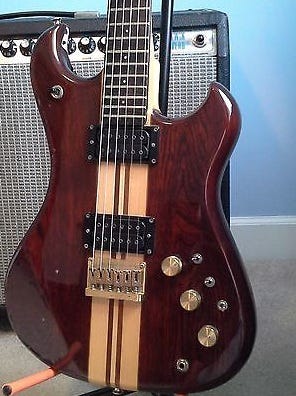The Bridesmaid Of Electra Phoenixes

If you've been reading me here or elsewhere for any length of time, you're probably aware that I collect guitars in general, Japanese guitars in particular, Matsumoku-made Japanese guitars to be specific, Electra-branded Matsumoku Japanese guitars to be precise, and the Electra Phoenix series to be exact. Whew.
I have quite a few of them now, to put it mildly. (Far too many to fit in a Transit Connect, for example.) With that said, the bewildering variety of the Electra lineup in the Eighties means that there are still quite a few that I don't have, even as my basement fills to chest height with black gigbags.
When I came home from the hospital, therefore, I was very pleased to see a bit of an Electra unicorn waiting for me. So pleased that I decided not to open it until I could stand up and play it. That day has come! It's an Electra X149. But what is an Electra X149? Let's start by looking at the price list:
My X130B is there, along with the other deluxe Phoenix guitars, at $349.50. (About nine hundred bucks in today's money.) It's worth noting that the dealers didn't discount much, if at all, back then. Above the deluxe Phoenixes is the active boost Phoenix, the X150, at $399.50. (Slightly over a grand today.)
The X150 is a tremendously important and interesting guitar --- if you're the kind of person who is prepared to find a thirty-year-old Japanese guitar tremendously important and interesting. Let's take a quick bite from the owners forum page:
The laminated body follows the identical stripe pattern with many other Matsumoku-made guitars of the time, including the Aria Pro, Westone, Washburn and Skylark models.
In addition to its beautiful body, the X150 also sported a most exotic feature for the time: onboard active EQ. The third toggle switch turned on the EQ; when this was on the middle knob boosted the output, and the third knob would had a center detent and would boost treble when turned clockwise and bass when turned counterclockwise. When EQ was off, the tone knob worked like a conventional tone knob.
Oh yes, remember the Skylarks? But if you're a Japanese guitar fan, or if you just played music in the Eighties, then the laminated center section screams "ARIA PRO II!" and rightfully so, the X150 was basically a way to combine the Matsumoku laminate body with Tom Presley's active EQ.

That's an X150. Note the active switches.

This is the guitar I just bought. It's an X149. Note the lack of active switches. Also, note the black knobs. These aren't original --- it should have the brass knobs --- but strangely enough, the only other X149 I've ever seen in pictures also has black knobs. Perhaps a dealer swapped them out.
The X149 doesn't appear in the price lists. So it was clearly an afterthought or a late model addition. Why does it exist? Presumably, it's a way for dealers who wanted the laminate body but who were scared of the Active EQ to have what they wanted. It must have sold for something between $349.50 and $399.50.
I own three X150s already, one of the "peace sign" early models and two of the later "Electra Phoenix" 1983 guitars. They're all brilliant players and made to the highest standards. Until December, however, I'd never even heard of an X149 for sale. Luck turned my way when a noted Electra collector and restorer decided to let this one go. It has a few nicks on the body, and it's possible the bridge isn't any more original than the knobs. It's bent brass, like a 1980 Electra, with the string-through saddles that typically mate to the milled bridges of the 1982-and-up Electras.

The neck has a lot of birds-eye in it and it's mirror-smooth. This X149 is the equal of my X150s in construction and playability --- no surprise, since only the electronics differed between the two. It's possible to cook up all sorts of scenarios as to why the X149 came to be, but certainly the Matsumoku obsession with Alembic-style laminated bodies had something to do with it. I'll ask Tom Presley when I get out to Indiana to interview him.
In the meantime, here's a random video featuring the X149 in a one-take performance of one of Donald Fagen's new songs. As you can tell, it's wound hot and offers a typical long-scale humbucker sound. All the mistakes in the video are my fault; the X149 is faultless. They're no longer really cheap on the used market; the next one to hit eBay should fetch between four and six hundred dollars. But it's worth every penny.

